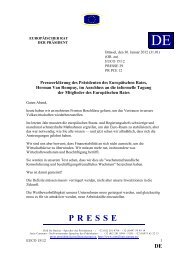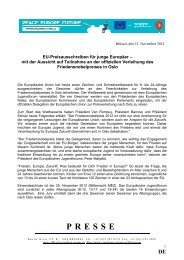14508/09 ADD 1 PL/vk 1 DG G COUNCIL OF THE ... - Europa
14508/09 ADD 1 PL/vk 1 DG G COUNCIL OF THE ... - Europa
14508/09 ADD 1 PL/vk 1 DG G COUNCIL OF THE ... - Europa
Create successful ePaper yourself
Turn your PDF publications into a flip-book with our unique Google optimized e-Paper software.
Women remain absent from leadership, political and entrepreneurial decision-making, from<br />
ownership in various companies, from the workforce of this sector and from the technical schools<br />
and scientific educational institutions where the future labour force is trained.<br />
The Climate Issue is one of the most salient environmental issues in the contemporary global<br />
debate. Gender aspects have been absent from the convention and the negotiations in the past (until<br />
Bali Cop13). Only a few women have been able to engage in or contribute to future climate<br />
policies. The proportion of female ministers who attend climate negotiations has been fluctuating<br />
between 15 and 20 % (Nordic Council 20<strong>09</strong>:12).<br />
At the March 2008 session of the United Nations Commission on the Status of Women (CSW) a<br />
panel debate was hosted on gender and climate. This event was followed by a Nordic conference on<br />
gender equality and climate change, hosted by the Nordic Council of Ministers in February 20<strong>09</strong>.<br />
At the conference 15 recommendations were drafted in preparation for the UN Climate Change<br />
Conference (COP 15) in Copenhagen in December 20<strong>09</strong>. The basic assumptions on climate change<br />
and gender are that women and men affect the environment differently and are affected differently<br />
by climate change, and that there is a considerable gender gap in decision-making relating to<br />
climate change (Nordic Council of Ministers 20<strong>09</strong>). This report also states that no data or studies<br />
have examined the connections between women's and men's behavioural patterns and climate<br />
change.<br />
However, studies have been conducted in climate-related sectors and these studies show that<br />
consumption and lifestyle patterns differ between women and men in rich countries as well. The<br />
difference is related to the gender division of labour and women's different access to resources,<br />
material wealth and power. Women have on average smaller incomes, less leisure time and<br />
generally consume less in comparison to men in the same geographical and social location. The<br />
gender division of labour means, for example, that women tend to work closer to the home and thus<br />
travel less often and shorter distances. A larger proportion of the male population than of the female<br />
use private cars and air travel far more frequently. Women tend to walk and use public transport.<br />
Mobility patterns seem to be shaped by different tasks in the division of labour (Vinz 20<strong>09</strong>:166).<br />
<strong>14508</strong>/<strong>09</strong> <strong>ADD</strong> 1 <strong>PL</strong>/<strong>vk</strong> 119<br />
ANNEX <strong>DG</strong> G EN

















